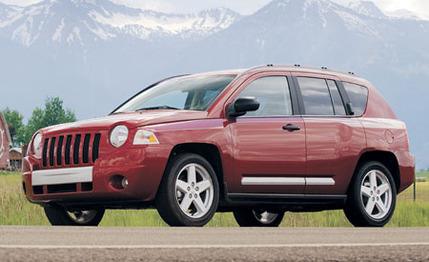
 Road Test
Road Test
Badges? We don't need no Jeep badges. Anyone can tell the Jeep Compass is a car, indeed, a station wagon pumped up to SUV dimentions, and not a Jeep. At least, not a Jeep in the high-Sierra, mud-slinging, rock-crushing definition of the term Jeep. Forget about the Halls of Montezuma -- the Compass is about the malls of Petaluma, about boldly going where sweaty-necked road-paving crews have already tread.
Jeep is busy having kittens. By the end of the year, the brand will have grown from four to seven models. Joining the Wrangler, Liberty, Grand Cherokee, and Commander are the Compass, Patriot, and four-door Wrangler Unlimited. The 2007 Compass is on sale as you read this. The Patriot, with a more conventional shipping-box SUV shape, is due this fall. The "Compatriots," as the Compass and the Patriot are practically twins, are the first truly soft-road Jeeps, very much cars with lower-hanging bellies (the Compass has ground clearance of 8.1 to 8.4 inches, depending on the tires) and limited appetites for dirt and slick rock. They are about as GI Joe as the Toyota RAV4, Honda CR-V, and Kia Sportage, against which the Compatriot twins are pitched.
To its credit, Jeep isn't denying it. Compass chief engineer Matt Liddane freely acknowledges that everything below the Compass's waist -- including the strut and multilink suspension; unitized floor-pan stampings; transverse 172-hp, 2.4-liter four-cylinder engine; and available five-speed manual or continuously variable automatic -- is shared with and assembled alongside the Patriot and Dodge Caliber in Belvidere, Illinois. Recall that the Caliber hatchback replaced the Neon/SRT4 sedan.
Why have both the Compass and the Patriot? Michael Berube, senior manager of Jeep Marketing, believes that customers are waiting. "The compact-SUV segment will double in the next five years, probably triple in the next 10." Back in 2003, competing concepts for a street Jeep and a dirt Jeep were pitched to DaimlerChrysler's board as potential spinoffs of the Caliber. Then Chrysler Group CEO Dieter Zetsche, perhaps having downed one Frappuccino too many, ordered the company to build both. The "Compatriot" was born.
"The Compass appeals to non-Jeep buyers," says Berube. "The Patriot is targeted at Jeep intenders who couldn't afford a Jeep until now."
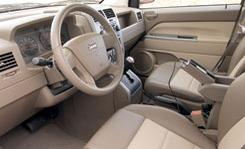
 Jeep built the Compass for poverty pricing. The bare-cupboard two-wheel-drive Sport starts at just $15,985. Freedom Drive I, which is the car's four-wheel-drive system, requires another $1599. The Limited, with more power accessories and glitz inside, begins at $20,140 for front-drive, $21,740 for the four-wheeler. Options such as a sunroof and chrome-plated 18-inch wheels can sling the price above $24,000. Ours rose to $23,575, with ruby-pearl paint ($225), a nine-speaker audio system that includes two speakers that swing down from the liftgate for back-yard boombox parties ($460), and the $1150 continuously variable transmission (Limiteds get the manumatic six-ratio AutoStick function with their CVTs).
Jeep built the Compass for poverty pricing. The bare-cupboard two-wheel-drive Sport starts at just $15,985. Freedom Drive I, which is the car's four-wheel-drive system, requires another $1599. The Limited, with more power accessories and glitz inside, begins at $20,140 for front-drive, $21,740 for the four-wheeler. Options such as a sunroof and chrome-plated 18-inch wheels can sling the price above $24,000. Ours rose to $23,575, with ruby-pearl paint ($225), a nine-speaker audio system that includes two speakers that swing down from the liftgate for back-yard boombox parties ($460), and the $1150 continuously variable transmission (Limiteds get the manumatic six-ratio AutoStick function with their CVTs).
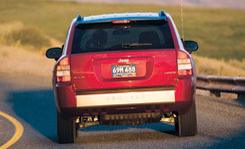
 Although the Compass and the Patriot are similar, Zetsche's decision still cost squillions. All exterior sheetmetal above the sills, plus the doors and the glass, is distinct among the Compass, Patriot, and Caliber. Mechanically, they are identical except for different suspension tuning and Freedom Drive I, the Compatriot's single-speed, electronically controlled all-wheel-drive system. The AWD Caliber has a similar slip-activated stack of computer-controlled clutches to engage the rear axle when needed, but only Compatriot drivers can also manually lock the clutch pack, while driving at speeds up to 10 mph, using a center-console switch. Traction control, stability control, anti-lock brakes, and curtain airbags are standard on all models, as is an anti-rollover gloss to the stability software. The Rubicon awaits!
Although the Compass and the Patriot are similar, Zetsche's decision still cost squillions. All exterior sheetmetal above the sills, plus the doors and the glass, is distinct among the Compass, Patriot, and Caliber. Mechanically, they are identical except for different suspension tuning and Freedom Drive I, the Compatriot's single-speed, electronically controlled all-wheel-drive system. The AWD Caliber has a similar slip-activated stack of computer-controlled clutches to engage the rear axle when needed, but only Compatriot drivers can also manually lock the clutch pack, while driving at speeds up to 10 mph, using a center-console switch. Traction control, stability control, anti-lock brakes, and curtain airbags are standard on all models, as is an anti-rollover gloss to the stability software. The Rubicon awaits!
Well, not exactly. With limited clearance and no low range, our Compass snagged itself on the dirt ruts from a lumber-yard forklift while mugging for photos. Real rock humping is out, although Jeep convincingly demonstrated Freedom Drive I's tractive capabilities by letting journalists plow through sand dunes.
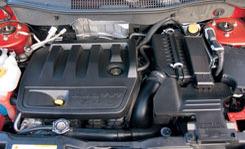
 Following that, we set the Compass on an extended expedition through northeastern Oregon. Like the blood-sucking Pacific lampreys that migrate up the Columbia River to spawn, we backtracked the path of Meriwether Lewis and William Clark through the Columbia River Gorge, past the one-million-kilowatt Bonneville Dam and the 1.7-mile-long hydroelectric dam at The Dalles, each with their fish ladders teeming with steelhead and chinook salmon. We skirted Mt. Hood unnoticed, crisscrossed the snow-salted Blue Mountains, and tiptoed around the glacier-frosted Wallowa Mountains before plunging into Hells Canyon. Across the Snake River we gazed at Idaho's Seven Devils Mountains, including the Devils Tooth, the She Devil Peak, and the He Devil Peak (tallest at 9393 feet) before heading back -- all on paved roads.
Following that, we set the Compass on an extended expedition through northeastern Oregon. Like the blood-sucking Pacific lampreys that migrate up the Columbia River to spawn, we backtracked the path of Meriwether Lewis and William Clark through the Columbia River Gorge, past the one-million-kilowatt Bonneville Dam and the 1.7-mile-long hydroelectric dam at The Dalles, each with their fish ladders teeming with steelhead and chinook salmon. We skirted Mt. Hood unnoticed, crisscrossed the snow-salted Blue Mountains, and tiptoed around the glacier-frosted Wallowa Mountains before plunging into Hells Canyon. Across the Snake River we gazed at Idaho's Seven Devils Mountains, including the Devils Tooth, the She Devil Peak, and the He Devil Peak (tallest at 9393 feet) before heading back -- all on paved roads.
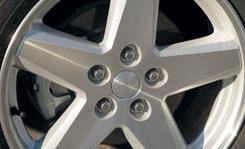
 A measuring tape reveals where Jeep is aiming with the Compass. A 103.7-inch wheelbase slots it between the current Honda CR-V (to be replaced later this year) and the newer Toyota RAV4. However, the Compass is narrower, shorter, and lower than both. The occupants, both in the front and rear, get plenty of head and leg room, but baggage capacity suffers. Blame the Compass's indoor spare tire and rear differential for jacking the load floor and pinching the baggage area to just 23 cubic feet behind the rear seats (54 with the 60/40 split-folding seats stowed).
A measuring tape reveals where Jeep is aiming with the Compass. A 103.7-inch wheelbase slots it between the current Honda CR-V (to be replaced later this year) and the newer Toyota RAV4. However, the Compass is narrower, shorter, and lower than both. The occupants, both in the front and rear, get plenty of head and leg room, but baggage capacity suffers. Blame the Compass's indoor spare tire and rear differential for jacking the load floor and pinching the baggage area to just 23 cubic feet behind the rear seats (54 with the 60/40 split-folding seats stowed).